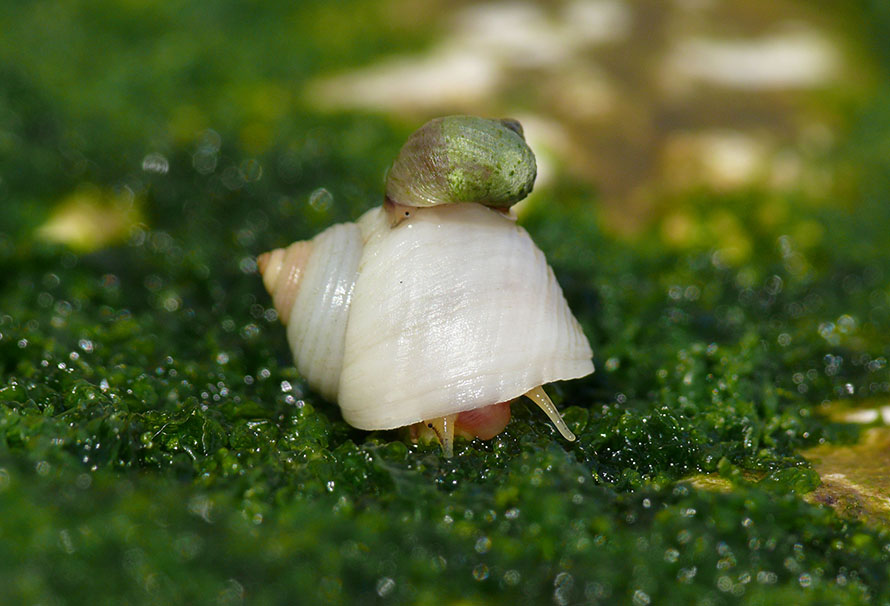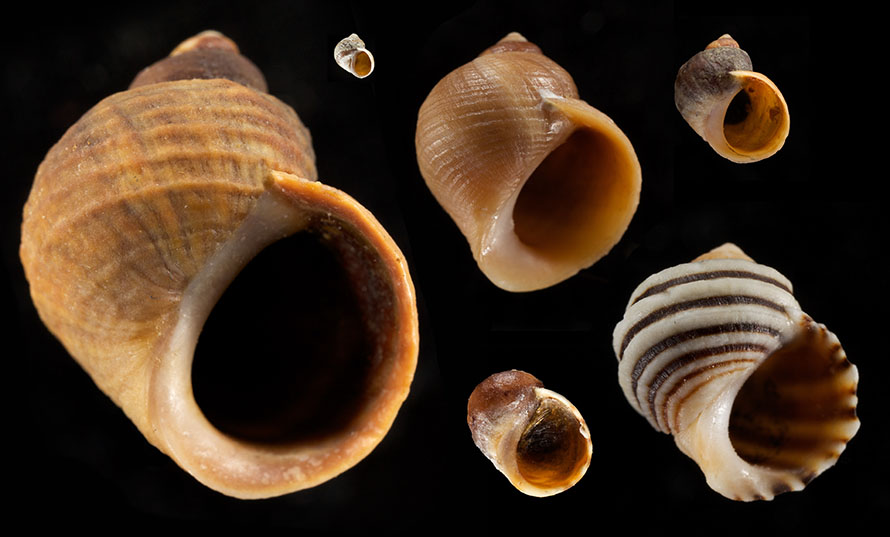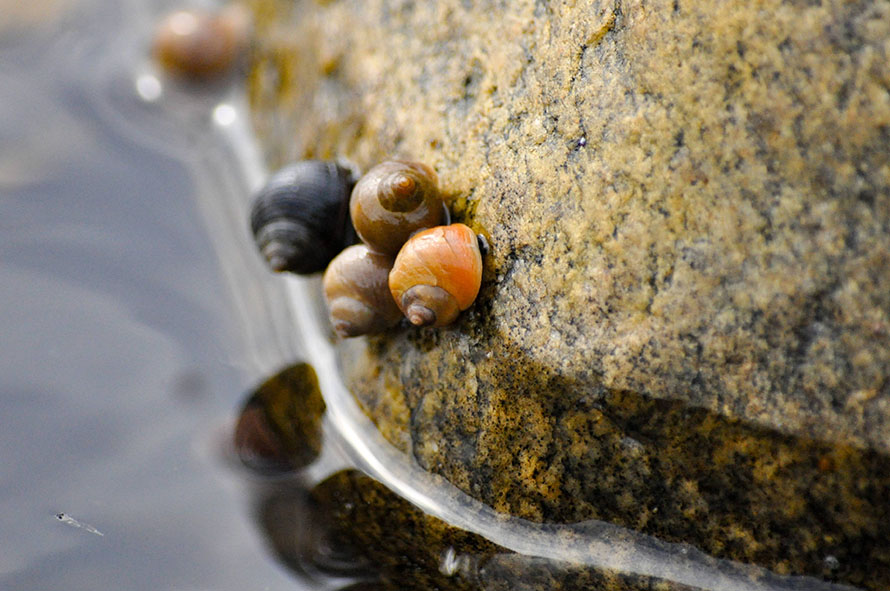The snail or the egg?
Animals reproduce in one of two distinct ways: egg-laying or live birth. By studying an evolutionarily recent transition from egg-laying to live-bearing in a marine snail, collaborative research by the Institute of Science and Technology Austria (ISTA), the University of Sheffield, and the University of Gothenburg has shed new light on the genetic changes that allow organisms to make the switch. The results were published in Science.

The egg did come first. Egg-laying arose deep in evolutionary time, long before animals even made their way onto land. Throughout evolution, there have been many independent transitions to live-bearing across the animal kingdom, including insects, fish, reptiles, and mammals. Yet, these examples have taught us very little about the number of genetic changes it takes to go from eggs to live offspring.
Now, an international team of researchers led by ISTA postdoc Sean Stankowski has used a humble marine snail to reveal the genetic changes that underpin the transition to live-bearing. The main advantage of investigating this phenomenon in marine snails: Live-bearing evolved within the past 100,000 years in these organisms—a blink of an eye in evolutionary terms. Thus, these marine snails could provide a unique chance to reveal the genetic basis of live-bearing. “Almost all mammals give live birth, and this function has accompanied their evolution for around 140 million years. Yet, in this study, we can investigate how live-bearing evolved completely independently, and much more recently, in marine snails,” says Stankowski. The team’s central finding: the switch to live-bearing is caused by around 50 genetic changes that are scattered around the snail genome.
One species, over a hundred names
The seaside marine snail Littorina saxatilis is the most misidentified creature in the world, The Guardian reported in 2015. Over centuries, scientists have described it as a new species or subspecies more than a hundred times, despite it being commonly found throughout the North Atlantic shores. This whole confusion must have stemmed from this species’ many shell variations and habitats. On top of this, L. saxatilis has a unique reproductive mode: it has evolved live-bearing while related marine snails that share its habitat lay eggs. “Scientists have mainly studied shell variation within L. saxatilis rather than what differentiates the species from its egg-laying relatives. The reality is that this snail species is the odd one out when it comes to its breeding strategy,” says Stankowski.

Losing the egg, one step at a time
An eye-opening moment was when Stankowski inferred the phylogenetic tree, or evolutionary “family tree”, of L. saxatilis and other related, egg-laying Littorina species, using whole-genome sequences. He showed that, although live-bearing is the only trait that distinguishes L. saxatilis from its egg-laying relatives, L. saxatilis did not seem to form a single evolutionary group. It was this mismatch between reproductive strategy and ancestry that ultimately allowed Stankowski and his collaborators to disentangle the genetic basis of live-bearing from other genetic changes throughout the snail genome. “We were able to identify 50 genomic regions that together seem to determine whether individuals lay eggs or give birth to live young,” says Stankowski. “We don’t know exactly what each region does, but we were able to link many of them to reproductive differences by comparing patterns of gene expression in egg-laying and live-bearing snails.” Overall, the results suggest that live-bearing evolved gradually through the accumulation of many mutations that arose over the last 100,000 years.
The costs and benefits of live-bearing
The research shows that the switch to live-bearing allowed snails to spread into new areas and habitats where egg-layers cannot survive and reproduce. But the precise benefits of live-bearing in these snails remain a mystery. “We don’t know for sure, but the transition from egg-laying to live-bearing may have arisen by natural selection favoring increased egg retention time, with the eggs eventually hatching inside the mother. We speculate that eggs might have been more susceptible to drying out, physical damage, and predators,” says Stankowski. In live-bearers, offspring are protected from the elements until they can fend for themselves, he adds. But by solving one problem, live-bearing would have certainly created others. “The extra investment in offspring would have almost certainly placed new demands on the snails’ anatomy, physiology, and immune system. It’s likely that many of the genomic regions we identified are involved in responding to these types of challenges”.

Mapping the function of each gene
Although the work sheds new light on the transition from eggs to live offspring, many questions remain to be answered. “Most genetic innovations are in fact really old and tangled up on an evolutionary scale which makes it difficult to study their origin,” says Stankowski. “These snails have allowed us to do exactly that, but we have only begun to scratch the surface of what they can teach us about the origins of novelty.” As a next step, the researchers want to map the function of each mutation. “We aim to understand how each genetic change shaped the snails’ form and function on the way to live-bearing, step by step,” concludes Stankowski.
This article originally appeared on the Institute of Science and Technology Austria website. Read it here.
Enjoy reading ASBMB Today?
Become a member to receive the print edition four times a year and the digital edition monthly.
Learn moreGet the latest from ASBMB Today
Enter your email address, and we’ll send you a weekly email with recent articles, interviews and more.
Latest in Science
Science highlights or most popular articles

Mining microbes for rare earth solutions
Joseph Cotruvo, Jr., will receive the ASBMB Mildred Cohn Young Investigator Award at the ASBMB Annual Meeting, March 7–10, just outside of Washington, D.C.

Fueling healthier aging, connecting metabolism stress and time
Biochemist Melanie McReynolds investigates how metabolism and stress shape the aging process. Her research on NAD+, a molecule central to cellular energy, reveals how maintaining its balance could promote healthier, longer lives.

Mapping proteins, one side chain at a time
Roland Dunbrack Jr. will receive the ASBMB DeLano Award for Computational Biosciences at the ASBMB Annual Meeting, March 7–10, just outside of Washington, D.C.

Exploring the link between lipids and longevity
Meng Wang will present her work on metabolism and aging at the ASBMB Annual Meeting, March 7-10, just outside of Washington, D.C.

Defining a ‘crucial gatekeeper’ of lipid metabolism
George Carman receives the Herbert Tabor Research Award at the ASBMB Annual Meeting, March 7–10, just outside of Washington, D.C.

The science of staying strong
Muscles power every movement, but they also tell the story of aging itself. Scientists are uncovering how strength fades, why some species resist it and what lifestyle and molecular clues could help preserve muscle health for life.

